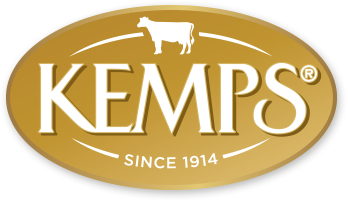Frequently Asked Questions
We’ve collected a list of our most commonly asked questions.
Have a new one for us? Well, just ask!
Kemps products including milk, sour cream, cottage cheese and yogurt are gluten free.
Ice cream itself is gluten free but may contain inclusions which contain gluten.
Anyone looking for a gluten free product should avoid the following ice cream products:
- ice cream sandwiches
- ice cream cones
Ice cream flavors which have the following inclusions contain gluten:
- apple crisp
- brownie batter
- brownie pieces
- cake pieces
- candies (may have a flour component that contains gluten)
- cheesecake
- cookie dough
- cookie pieces
- graham cracker
- pie pieces
- spumoni (the color contains gluten)
Products containing gluten are manufactured in the same manufacturing facility as gluten free products.
Kemp’s has always had strict Good Manufacturing Practices (GMPs) to avoid cross-contact of our gluten free products with gluten and we continue to strengthen these practices.
The GMPs include employee training, strict raw material control, production schedule management and sanitation practices that include performing thorough equipment wash-downs to eliminate cross-contact of ingredients.
We have an allergen control program in our ice cream plant. However, we do NOT have a dedicated line for nut containing products. We recommend that you consult with your doctor regarding the risk.
At our ice cream manufacturing facility, we do not use any tree nuts or peanuts on the equipment that produces IttiBitz flavors. In fact, IttiBitz flavors are manufactured in a separate room at our Rochester location that does not handle any tree nuts or peanuts.
If additional information is required, please contact Kemps Consumer Relations toll free at 1-800-726-6455.
| Type of Milk | Potassium | Phosphorus | Calcium | Magnesium |
| Vitamin D | 370 mg | 228 mg | 290 mg | 33 mg |
| 2% Reduced Fat | 388 mg | 232 mg | 297 mg | 33 mg |
| 1% Lowfat | 381 mg | 235 mg | 300 mg | 33 mg |
| Fat-Free Skim | 406 mg | 247 mg | 302 mg | 33 mg |
When frozen and thawed, most dairy products will separate and become watery and discolored.
Milk! It’s a great source of calcium and vitamin D, which the body needs to absorb calcium. If you don’t care to drink milk, there are many ways to incorporate milk or other dairy products into your diet. Whipping up a smoothie with milk, bananas and ice, or a large decaffeinated café latte (which is made with lots of milk) are easy ways to get your three servings of dairy every day. Your body needs at least 1,000 milligrams of calcium per day, which is about the amount found in three serving of dairy products.
30% RDI of calcium represents 300 milligrams of calcium per 8-ounce serving of milk. The amount of calcium in each type of milk varies slightly. Eight ounces of Vitamin D milk contains 290 milligrams of calcium. Eight ounces of 2% milk contains 297 milligrams of calcium. Eight ounces of 1% milk contains 300 milligrams of calcium. Eight ounces of skim milk contains 302 milligrams of calcium. The reason that minerals vary with fat type is that the minerals are part of the milk solids, NOT the fat in the milk. As the fat goes down, milk solids go up.
Milk is an excellent source of calcium and Vitamin D. It’s also a good source of other nutrients, such as protein and phosphorus that are necessary for strong bones and good health. Milk doesn’t have to be fattening. If you’re concerned about fat in milk, don’t be. Kemps Fat Free Milk is a delicious and nutritious beverage choice.
When properly refrigerated, between 33 and 40 degrees F., Kemps Sour Cream and Cottage Cheese will retain their wholesomeness for one week past the date printed on the package.
0 degrees F or colder.
Frozen desserts may be kept as long as 3 months (unopened) if stored at 0 degrees. Once opened, ice cream can remain fresh for about 3 weeks. Avoid storing ice cream in the front end of the freezer, near the door, where it is constantly exposed to fluctuations in temperature.
They are ingredients used to provide a smooth, creamy texture and are derived from soybeans.
Dairy products must be refrigerated between 33 degrees F and 40 degrees F. It is important to note that for every 2 degrees F rise in temperature, milk’s shelf life is reduced by 50%. Pour out only the amount of milk you will use and return the container to the refrigerator immediately, resealing to prevent absorption of other flavors. Do not pour milk that has been standing at room temperature back into the container. Store it separately in a covered container.
Homogenization is the process of breaking up milk fat into smaller globules, dispensing them permanently in a fine emulsion throughout the milk. This is done in a homogenizer where milk is forced under high pressure through very tiny openings.
Pasteurization is the process of heating raw milk to at least 145 degrees F and holding continuously for at least 30 minutes, or to at least 161 degrees F and holding for at least 15 seconds, in approved and properly operated equipment. The milk is then cooled promptly to 45 degrees F or lower. This process is done to ensure high quality and safe milk.
Reference Daily Intake (RDI) is the daily intake level of a nutrient that is considered to be sufficient to meet the requirements of 97-98% of healthy individuals in the United States. The RDI is used to determine the Daily Value (DV) of foods, which is printed on nutrition facts labels (as % DV). So for example, the RDI for Vitamin D is 20 mcg. So on the nutrition facts panel you will see that milk has 2.5mcg, which is 10%DV or 10% of the RDI.
